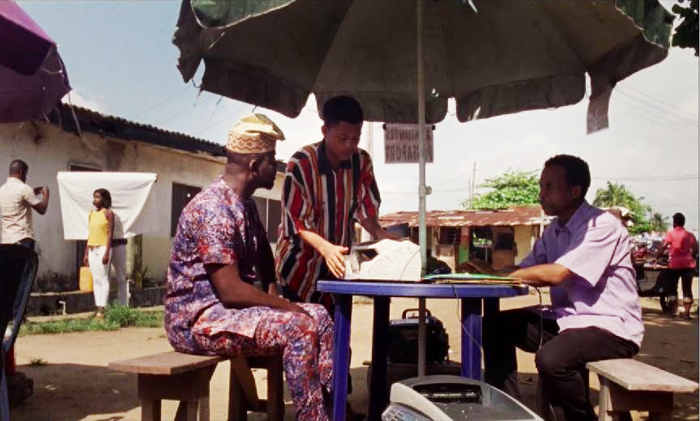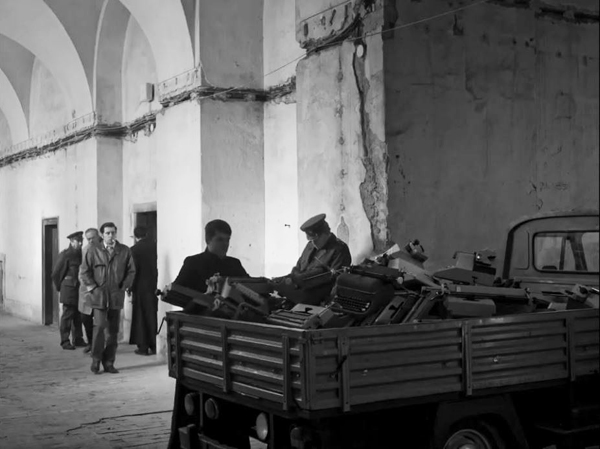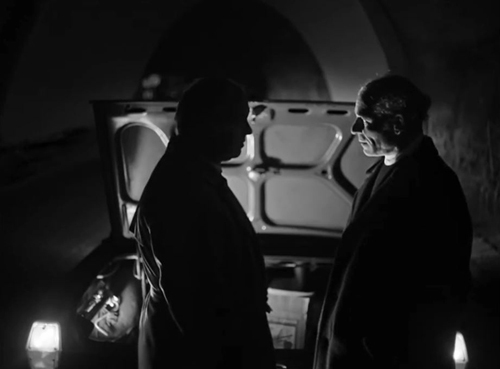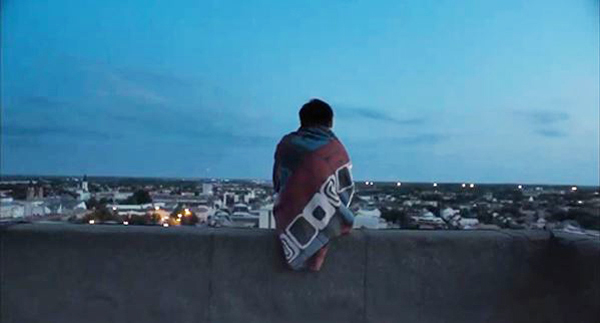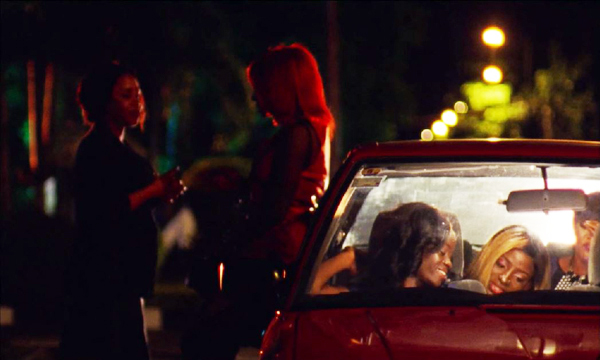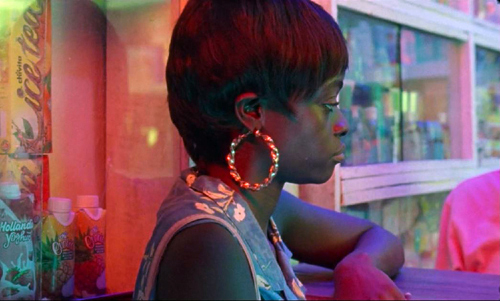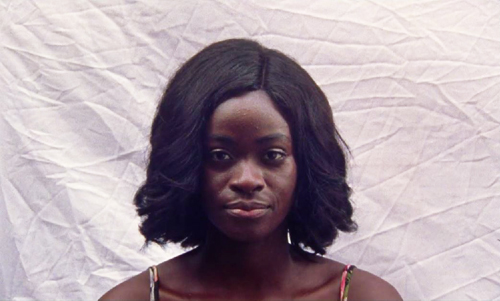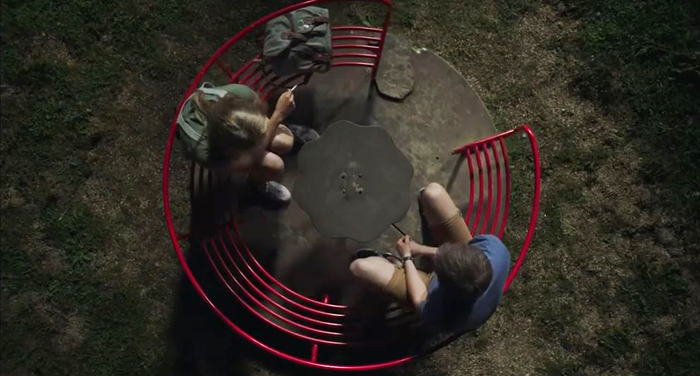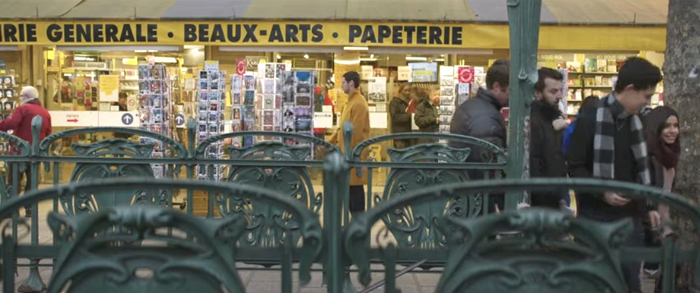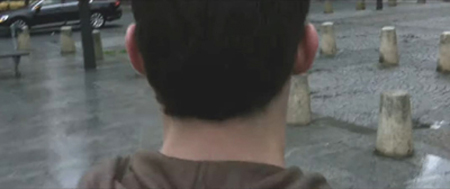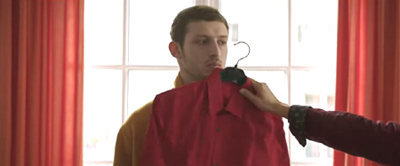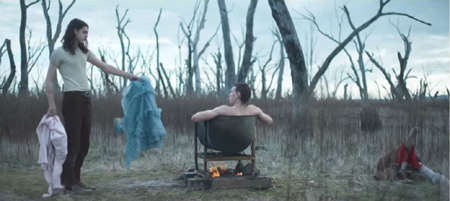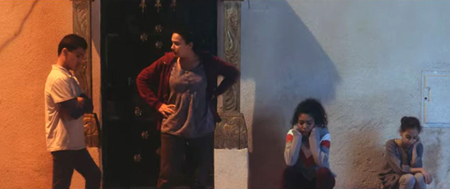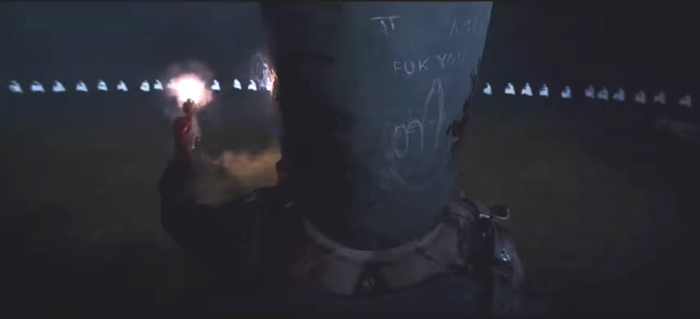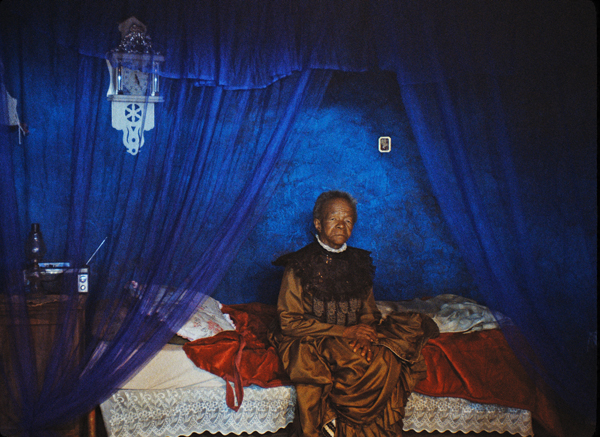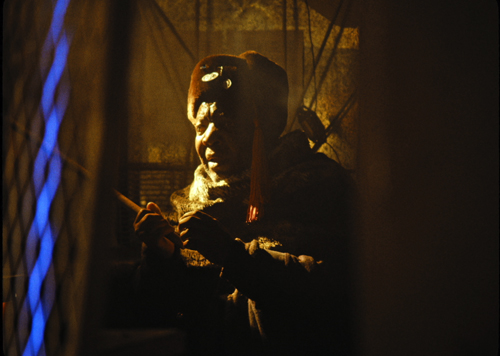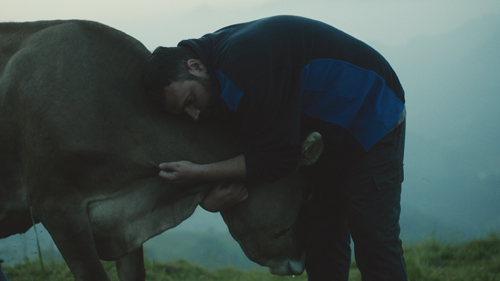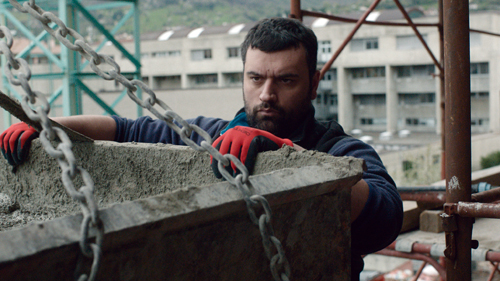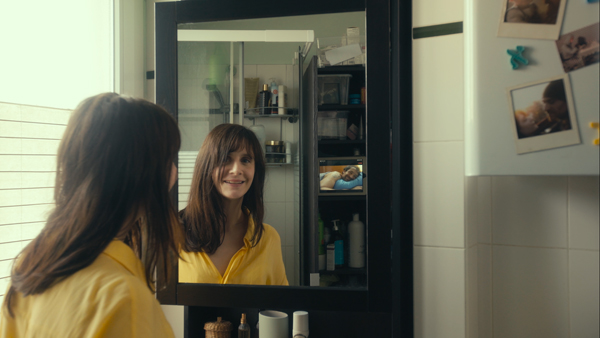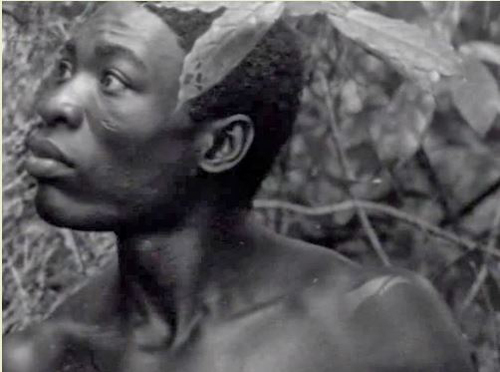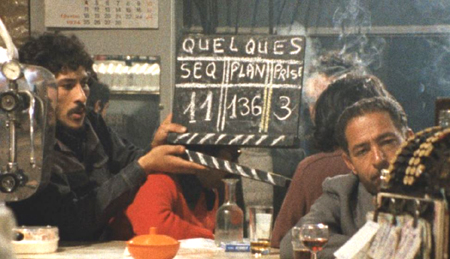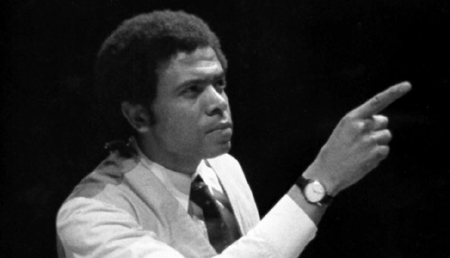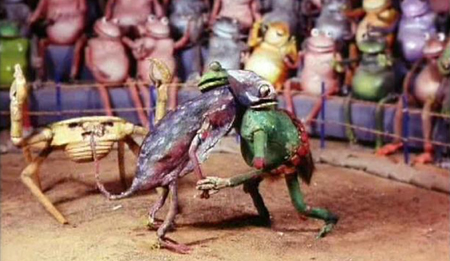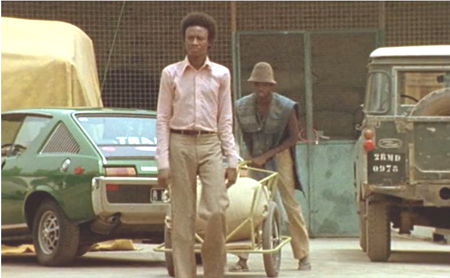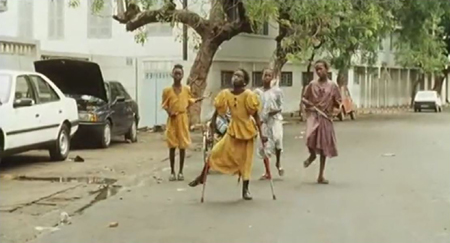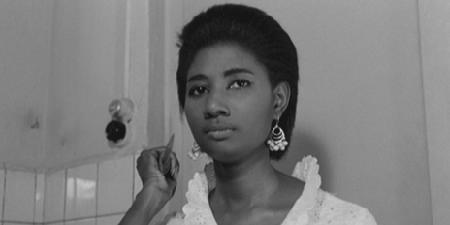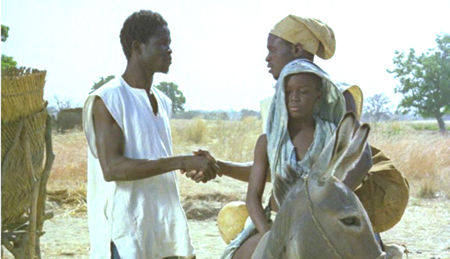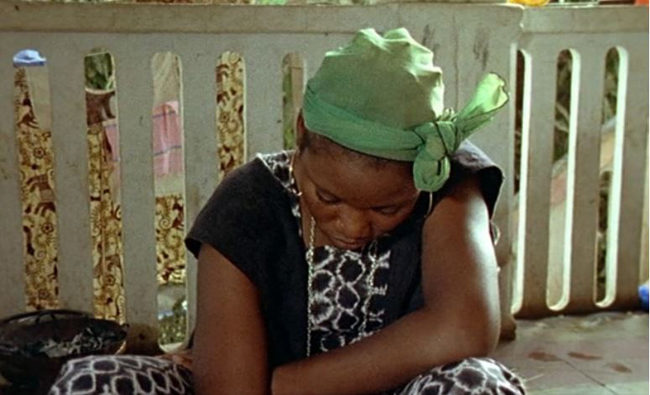Archive for the 'National cinemas: Africa' Category
Vancouver: Continuing our world tour
Eyimofe (2020)
Kristin here:
Turning back from documentaries to international art cinema, I’m recommending three films, two from Eastern Europe and one from Nigeria.
Servants (2020)
Ivan Ostrochovsky, an established Slovak producer of documentaries, whose first feature Goat (2015) was successful on the festival circuit, has followed it up with a second. Servants showed in the Encounters program at Berlin and earned enthusiastic reviews (Variety, Screen Daily).
The film opens with a flashforward as a body is dumped on a dark country road–a scene that will later be replayed when we have more information as to who the victim is. Suddenly a title, “143 days earlier,” appears, and the plot focuses on two beginning seminary students, Juraj and Michal. Briefly we seem to following their personal stories, but their introduction to the seminary routine serves largely as exposition for us. Signs of Communist repression of Catholicism begin to surface. A defiant note anonymously posted leads to a confiscation of all the students’ typewriters (above) in a search for clues as to its author.
The organization behind the repression is an actual historical agency, “Pacem in Terris,” which spied on and controlled the Catholic Church, from 1971 to the early 1980s. (The film is set in 1980.) Its goal was to seek out any signs of political activity, i.e., rebellion, among the clergy and seminarians. Juraj and eventually Michal join a small clandestine group of students working against Pacem in Terris. They become the targets of a ruthless agent, “Doctor Ivan,” (seen at the right below). He is the man responsible for the body-dumping in the opening.
Servants, impressively shot in black-and-white, has been called a film noir, and it certainly has all the sinister tone, the chiaroscuro lighting, and the ill-fated heroes of that genre, mixed with the trappings of art cinema.
Ivanovsky demonstrates how much suspense and dread can be packed into a mere eighty minutes.
On the Quiet (2019)
Another short feature that packs a lot of drama into its 81 minutes is Hungarian director Zoltán Negy’s first feature, On the Quiet. It deals with the touchy subject of alleged sexual abuse of a minor. The film’s smart script, co-written by Negy, is credited as having been developed at the “My First Script Workshop” of the Zagreb Film Festival. As I have suggested elsewhere, such workshops run by festivals have come to play a major role in making such sophisticated storytelling possible.
The main strength of the script is how it maintains an utterly balanced ambiguity about the allegations at its core. The beginning introduces the protagonist, Dávid, first violinist in a student orchestra in a prestigious music school. The teacher-conductor, Mr. Frigyes, employs eccentric techniques with the players. When Dávid fails to perform his solo part adequately in rehearsal, Frigyes tells the other students to gather round to massage his shoulders. This apparently helps him improve.
Soon Frigyes is giving private lessons to 14-year-old Nóri, a pretty, inexperienced but talented cellist. The first lesson we witness has him relaxing her by having them toss a ball back and forth. He touches her elbow and shoulder to adjust her posture. That is all that we witness. Yet soon Nóri complains to Dávid that the teacher has done “weird” things to her, but she won’t specify except to say they were “intimate.” Disturbed by this, Dávid gives her his phone to secretly record a lesson with Frigyes. The resulting dialogue could equally be the teacher directing the girl’s cello technique or instructions about sexual caresses. Dávid’s girlfriend points out to him that Frigyes uses his touchy-feely approach with all the students, but he persists in trying to discover the truth.
The situation escalates as Dávid informs a female counselor, who interviews Nóri and her mother. The girl denies that anything untoward happened. Still, the gossip spreads and the situation eventually threatens Frigyes’s position at the school. Did he abuse the girl? Did he simply not realize how his hands-on guidance could make the girl uncomfortable? Is she naively over-reacting to teaching methods that don’t seem to bother the other students?
I have seen one review that simply declares that the teacher is a perverted abuser, but the film seems far more subtle to me. Without ever implying that Nóri’s complaints should be dismissed, the film explores the effects of the spreading rumor on all those involved. It does show that no real investigation of the claims, which would be the logical way to proceed, ever takes place. In short, it is a careful presentation of its sensitive subject.
The film is well directed, though far from flashy. It does have the occasional striking shot, as when Dávid ponders the situation one evening (above) or sits talking with Nóri on a playground merry-go-round in an overhead shot (see bottom) that hides their expressions and suggests his confusion.
An interview with Negy about the film suggests that he is a thoughtful as well as a promising director–and one with three more film scripts underway.
Eyimofe (2020)
From the early 1990s, Nigeria has built up a thriving production of low-budget, DIY and professional films. At first distributed on VHS tape and then on digital disk, these have had enormous success at home and among the African diaspora. Kunle Afolayan formed a company that commanded government support and product placement to finance October 1 (2014), which played at film festivals, mostly within Africa. More recently, Kemi Adetiba’s The Wedding Party (2016) premiered at the Toronto International Film Festival, and Kathryn Fasegha’s 2 Weeks in Lagos premiered at the 2019 Cannes festival, where it was somewhat overshadowed by Mati Diop’s Atlantics, playing in competition.
Now comes Eyimofe (This Is My Desire, in English, but much of the coverage on the internet uses the Yoruba title). It is directed by twins crediting themselves as Arie and Chuko, though their family name is Esiri. They have created an formally and stylistically impressive film that gives fascinating insights into the society of the sprawling conurbation of Lagos, an area with an estimated population of 21 million.
Arie Esiri studied Screenwriting and Directing at Columbia University’s School of the Arts, while Chuko Esiri earned an MFA, also in Screenwriting and Directing, from New York University’s Tisch School of the Arts. They wisely shot Eyimofe on 35mm, and the lush visuals exploit the bright colors of Sub-Saharan African clothing (see top of entry) and furnishings. Cinematographer Arseni Khachaturan adds bright colored light, especially at night and in shops, to create a gorgeous look (above and below).
The plot is split into two parts via titles: “Spain” and “Italy.” In each part, the main character is struggling to migrate. Mofe, an electrician, is gradually collecting the documents and money he needs for his move to Spain, where he will adopt the name Sanchez. Rosa, working both as a beautician and cocktail waitress, has similar aspirations to relocate to Italy, taking her younger sister Grace along. Both protagonists must scrape up money to pay for the passport, visa, fake letters promising employment, and other expenses. There are many complications, including a death in Mofe’s family and an unexpected revelation of the lengths to which Rosa and Grace will go to secure their passage.
The two stories are largely separate. There are moments when the characters pass each other briefly, and Grace even chats with Mofe at a little repair stand he sets up. Yet none of these chance encounters involves any causal connections between the two plots.
Early in the film Mofe visits an open-air “office” where a man who specializes in getting passports and visas–for a hefty fee (see top, where Mofe is on the right). In the background we glimpse a woman getting a passport photo taken against a white cloth. Late, near the beginning of the “Italy” section, we meet Rosa, having her passport photo taken in front of a similar backdrop (below). She’s in a different passport shop, however, suggesting that such informal establishments, vital for aspiring emigrants to cut through the red tape and delays of government procedures, are common in Lagos. It’s also the first of several parallels between her story and that of Mofe, clearly intended to suggest how common such struggles to leave for Europe are.
Unlike Mofe, Rosa aspires to a fun, modern social life, buying fancy clothes while sleeping with her landlord (who happens to be Mofe’s landlord as well) and then starting an affair with a wealthy Lebanese-American businessman. Her nightlife offers the occasion for flashy images, including the positively Godardian composition of her in a car with her friends (at the top of this section). As with Mofe, an unexpected death helps derail her plans, and we learn just how far she and Grace had been willing to go in their hopes for a better life abroad.
Eyimofe is a powerful film and well worth seeking out at a festival or on streaming. It’s having its UK premiere at the London Film Festival, which starts tomorrow. For a brief discussion by the directors about the film’s background, financing, and festival life, listen to this BBC radio interview. For a detailed description of the film’s success during its screenings during the Berlin festival from a Nigerian point of view, see here.
As a remarkably rich and successful festival draws toward its end, special thanks to Alan Franey, PoChu AuYeung, Jane Harrison, Curtis Woloschuk, and their colleagues for their help during it.
On the Quiet (2019).
Torino tour of world cinema
Synonymes (2019).
Kristin here:
After visiting museums on the one free day we allowed ourselves in Turin before the festival began, we launched into viewing films from around the world. Here are three of the best we’ve seen, to add to the ones David has discussed.
Synonymes (France/Israel/German, dir. Navad Lapid)
Israeli director Navad Lapid has become a familiar figure for us as we have visited past festivals in Vancouver. We blogged about his Policeman in 2011 and The Kindergarten Teacher in 2014. His latest film raises his profile considerably, having won the Golden Bear at Berlin and had its North American premiere at Toronto. (Ozon’s By the Grace of God, which we blogged about from Vancouver, won the Silver Bear.)
Synonymes started with an abrupt chase, with the camera bouncing about as it follows our hero, Yoav, as he dashes through the streets of Paris (above). I was worried that this loose style of shooting would dominate, but Lapid has something more disciplined involved. The unfastened camera is usually used for exteriors, while interiors are made up of static shots.
He arrives at a large empty flat that someone has loaned him, where the heat has apparently been turned off. He proceeds to take a cold shower, and, having neglected to lock the door, he finds his backpack and sleeping bag stolen. He is left naked with no possessions whatsoever. A wealthy young couple from downstairs rescue him from hypothermia and become fascinated with him, taking him in briefly. Émile gives him money, as well as clothes. He holds up a long series of colorful shirts, which he himself apparently never wears, judging from his own muted wardrobe.
Lapid matches these colors to the decor, especially the distinctive, bright mustard-hued overcoat that Yoav wears through much of the film. The coat makes him easy to spot and marks him as an outsider among the more conventionally dressed Parisians around him (see top).
We soon learn that he is fleeing from his oppressive life in Israel and wants to become a Frenchman as soon as possible, refusing to speak anything but French despite his elementary grasp of the language. (The title comes from his habit, when wandering around alone, of muttering a series of words with similar meanings.)
There’s not much of a goal operating here, apart from Yoav’s increasingly strained efforts to turn himself into a Frenchman and abandon the violence inculcated into him by his time in the Israeli army. His one conventional job is as a security guard at the Israeli consulate. His violent outbursts and willfully eccentric behavior increase as the film goes along.
The rather episodic film revolves around the driven performance of Tom Mercier, an Israeli theater student who knew no French and, remarkably, is making his film debut here.
Kino Lorber has released Synonymes (as Synonyms )in North America. For a plot summary and a list of theaters where it has played and will be playing into January of next year, see the company’s webpage.
True History of the Kelly Gang (Australia, dir. Justin Kurzel)
Bushranger films, of which True History of the Kelly Gang is one, are more or less the Australian version of American westerns. The tale of Ned Kelly and his gang is almost a mini-genre in itself, going back to what is claimed to be the world’s first feature film, The Story of the Kelly Gang (1906, dir. Charles Tait, partially surviving).
Justin Kurzel adopts a fresh take on the familiar Kelly tale, which is as much myth as fact. He based his film on Peter Carey’s novel of the same name, which won the Booker Prize and many other awards. By adding “True” to his title, Carey both acknowledged the fact that he was embroidering the national legend as much as adhering to the facts.
Kurzel does the same. A title appears on the screen: “Nothing you are about to see is true.” All of the words besides “true” fade out, and the rest of the film’s title fades in beside it. Those of us not steeped in Australian history and culture will not be able to fill in the inauthentic parts, but it doesn’t really matter. It’s a gripping story nonetheless.
The film opens when Ned is a boy, living with his mother Ellen and siblings in a bleak part of the bush consisting mainly of stubby dead trees (above). Although an honest lad to start with, he is drawn into the family’s long-time opposition to the local constabulary and military forces. Despite her fierce love for her family, Ellen sells him into apprenticeship to a putative merchant and herder (played with not quite too much gusto by Russell Crowe). The man turns out to be a highway robber, and Ned is reluctantly pushed toward a life of crime.
The film follows the novel in using a voiceover narration by Ned, reading from a diary purporting to be for his young daughter after his inevitable demise. (In fact the figures of the wife Mary and the daughter are part of the tale’s embellishment.) Indeed, we are nearly always in his presence and are led to sympathize with him because almost everyone around him except Mary exploits him.
The film is visually impressive, including some shots that leave one wondering how they were accomplished. At intervals there are fast drone shots above the sea of dead trees as Kelly and others ride horses through the landscape. One shot at night features an immense pool of light from above that moves smoothly with the horseman, keeping him visible as the stark gray trees appear from and disappear into the inky surroundings.
The climactic shootout between Kelly’s gang of four men in home-made armor and a large posse approaching from the distant background provides an unforgettable image. The last man standing, Kelly himself, back to camera, fires at a line advancing figures. They appear spread across the screen as tiny white figures–looking distinctly like Ku Klux Klan men in full garb. (See bottom.)
True Story of the Kelly Gang contains considerable strong profanity and violence, which would seem to warrant a risky hard-R rating in the US. Nevertheless, just before the film’s world premiere at Toronto, IFC acquired the North American rights to the film for a reported seven-figure sum, bidding against three other distributors. IFC will evidently release it in 2020. (The first trailer has just been posted on Youtube, but there is currently no mention of the film on the IFC website.)
Noura’s Dream (Tunisia/France/Qatar, dir. Hinde Boujemaa)
Increasingly female directors working in Middle Eastern and North African countries are gaining a foothold in the international film market. Recent notable films have been Saudi director Haifa Al Mansoor’s The Perfect Candidate in competition at Venice and Nadine Labacki’s Lebanese film Capernaum, Jury Prize winner at Cannes in 2018.
Tunisian director Hinde Bujemaa’s Noura’s Dream centers on a woman with three children who is awaiting an imminent divorce from her incarcerated husband, Jamel, so that she can marry her lover, a car-repairman, Lassaad. Meanwhile she is working in a laundry to enhance her government checks and support her family (above).
Though Tunisia is somewhat more liberal than other Muslim countries, Noura still faces traditional prejudices. In the opening scene, an official tries to talk her out of the divorce for the sake of her children–as if living with an abusive criminal for a father is more desirable than having a kinder stepfather.
Jamel is released unexpectedly early, and Noura must live with him for the few days until the divorce is final. She pretends to be considering staying with him, despite the fact that he returns to his criminal activities and abuses his family, at one point throwing them out of the house (above). As Bujemma points out in a Variety interview, however, Jamel is not all bad, not taking the option of betraying to the police Noura’s adultery with Lassaad, still a criminal act in Tunisia.
In a way Noura’s Dream seems to reflect the considerable impact that Asghar Farhadi’s Oscar-winning films have had on other directors in the region. The situation of an impending divorce recalls A Separation, yet Farhadi’s films tend to have quiet, “everyone has his reasons” plot arcs with twist revelations and moral ambituities. Here, telling such a story and eager to display the biases against women in Tunisian society. Bujemma takes a more melodramatic approach. Jamel is an unrepentant criminal and Noura is a brave, determined woman struggling to separate herself and her children from him. Lassaad is a decent fellow nevertheless ultimately driven to reject her when she shows no signs of leaving Jamel.
It’s a film that effectively builds up considerable sympathy for Noura, played by prominent Middle-Eastern star Hind Sabri, and withholds hope, or possible hope, until the last shot.
Noura’s Dream has played several festivals, including Toronto, London, and now Torino and has releases in Europe and its native country, but there is so far no North American distributor.
The Horror Thread
As David mentioned in our previous post, the Torino Film Festival includes a retrospective program each year. This time it was horror films, from Das Cabinet des Dr. Caligari to Roy Ward Baker’s Dr Jekyll & Sister Hyde (1971, UK). I fit some of these into my schedule in between the new films.
There were 35mm prints of I Walked with a Zombie (1943, Jacques Tourneur), The Masque of the Red Death (1964, Roger Corman) and The Devil Doll (1936, Todd Browning), among the films I saw. The DCPs of The Body Snatcher (1945, Robert Wise) and The Innocents (1961, Jack Clayton), the latter shown immediately after the former, offered two gorgeous examples of black-and-white cinematography. In all the retrospective included 36 films, many of them probably being viewed by Italian attendees for the first time in their original languages, rather than dubbed versions.
We wish to thank Jim Healy, Emanuela Martini, Giaime Alonge, Silvia Saitta, Lucrezia Viti, Helleana Grussu, and all their colleagues for their kind help with our visit.
For more Torino images, visit our Instagram page.
True Story of the Kelly Gang (2019).
Finding a form: The College Cinema at the Venice International Film Festival
This Is Not a Burial, It’s a Resurrection (Lemagang Jeremiah Mosese, 2019).
DB here:
For the third year I participated in the Mostra’s College Cinema, a wonderful program that funds and guides three features by up-and-coming directors and producers. (Details are here.) I’ve reported on the earlier sessions here and here.
This year my developing reaction to the trio of features was governed by what Kristin and I did the day before our panel. We saw two superb classics: Bertolucci’s The Spider’s Stratagem (1970) and István Gaál’s Current (1964). They reminded me of what ambitious filmmaking was like before the arrival of screenplay manuals dictating character arcs and first-act turning points.
In those days, a filmmaker was likely to find a distinct, even unique form for a story. The filmmaker would design the film organically, creating a large-scale shape that would let technique and dramatic structure build in relation to each other, not in accord with standard formulas.
Coupling via monitor
A good example is The End of Love, directed by Karen Ben Rafael. The Israeli Yuval and the French woman Julie have a child. He waits in Israel for a new visa, while Julie must manage child care under the pressures of her job in an architecture firm. Each begins to suspect the other of infidelity, and their families in each country add to the tension.
So much for a traditional “relationship” movie, whose ups and downs could have been presented in a standard way. But Rafael and her co-screenwriter Elise Benroubi hit upon a fresh way to trace the couple’s conflicts. Yuval and Julie are keeping in touch via a Skype-like video service, and we are completely confined to their exchanges in this medium. We see only what they see, in a series of to-camera shot/reverse-shots.
Some recent genre films have been “monitor movies,” like Paranormal Activity 4 (2012), Chronicle (2012), Unfriended (2014), and Searching (2018). But these exploit the device for suspense and horror. The End of Love lets the conditions of video communication structure the ongoing drama. A teasing opening suggests that the camera is lying in bed between the couple as they caress themselves; the next scene–a remarkable shot in itself (above)–reveals that video is their channel of communication.
As the film goes along, tensions between Yuval and Julie are presented as much through the mechanics of video exchanges as through the actors’ (very persuasive) performances. Unanswered calls signal a growing indifference. A mysterious shot wobbling through a dance club suggests either a phone accidentally turned on or a loud, defiant assault on the other person. I was especially taken by the moments when we get slight change of eyelines as characters look from the camera to study the display image of the other person.
The End of Love triggers a lot of ideas about how modern couples are led to expect that technology can overcome family problems. Being always online, always “in touch,” doesn’t mean that you’re engaging authentically with someone else. For all its power, the video hookup in the film creates an illusory intimacy, and its glitches stand for the aggravations, little and big, that come with physical separation. This thematic implication grows organically out of the creative decision to confine our viewpoint to what the camera can see and hear, but not heal.
Social drama into community myth
Another vigorous example of letting the material summon up the film’s form is This Is Not a Burial, It’s a Resurrection. Directed, written, and edited by Lemogang Jeremiah Mosese, it’s a poetic work that develops its imagery out of a dramatic situation.
The eighty-year-old Mantoa learns that her only surviving relation, her grandson, has died in a mining accident. After being consoled by her priest and the local choir, Mantoa tries to restabilize her life. But when she learns that her village is to be flooded for a dam project, she vows to save the bodies in the local cemetery–and to prepare her own grave.
This tale, set in Lesotho, is framed by a narrator telling us about her and her community. He sits in a blast of yellow light adjacent to a pool hall, and at intervals the story action pauses for his comments. The film takes its time–about 300 shots in two hours–to dwell on the details of her daily routine, such as the portable radio hanging from the wall, or Mantoa’s changing outfits.
But there are also more surreal images, such as Mantoa on a burned-out bedspring being slowly surrounded by sheep. The community that eventually supports her is presented as an almost abstract force, as are the out-of-focus government workers slowly hacking away at the perimeter of the village. The climax of the film makes powerful use of those figures as Mantoa confronts them in her boldest provocation of all.
Again a familiar situation–a tenacious elder tries to halt the destruction of a community (think Wild River)–is given fresh life through formal elaboration. Out of a primal conflict, Mosese generates a work of mythic dimensions. He does it through lustrous visuals, an evocative soundtrack, and a character who creates a legend that will live for generations.
Town and country
If The End of Love traces a jagged decline in a relationship, and This Is Not a Burial lifts a social conflict into spirituality, Lessons of Love finds another structure, this one aiming to express the inarticulate feelings of a man stuck in a situation. It’s a circle.
Yuri toils on his father’s farm, while his younger brother and sister try to avoid their responsibilities. Stolid, silent, and glum, Yuri harbors a good deal of anger, occasionally expressed in road rage. He relates to the world almost completely through physical contact.
Director Chiara Compara and her co-screenwriter Lorenzo Faggi start from a classic pattern: the migration of an innocent from the countryside to the city. This pattern is refreshed through a strategy going back to Neorealism: the insistence on the physicality of daily routines. A prolonged moment of Yuri tuning a radio recalls the famous scene of the maid’s morning ritual in Umberto D.
The early stretches of Lessons of Love stress the demands of farm work. The first shot is of a milk can, and soon we see logging, veterinary inspections, the purchase of a cow, and the dull evening meal. But we also get a sense of Yuri’s longing when he soberly eats during a TV love scene, and soon enough he’s visiting a strip club, watching as impassively as he did the TV show.
Through a tissue of routines, Yuri’s vague thoughts about escape emerge, and soon he is considering buying cowboy boots, dating Agata, and getting a construction job in town. That’s when the circular structure gets initiated, and new routines replace the old ones. Again, the details of hard labor aren’t stinted, and Yuri is challenged to break out of his smoldering solitude. Can a man who punches and embraces his favorite cow, and who furiously whacks a driver-side mirror, ever learn to talk to a woman who’s kind to him? The last shot of the film, discreetly echoing the first, provides the answer.
A fraught love affair, a defiant elder speaking up for a community’s heritage, and a lonely, locked-in man are familiar enough points of departure for a film. But these three College features offer fresh, rigorous treatment of their stories. Three acts and vulnerable-but-relatable heroes and heroines? Not necessary! There are other ways to go, as young filmmakers can show us.
Thanks as usual to Peter Cowie for inviting me to join the College Cinema panel, and to Savina Neirotti, the Head of the program. Thanks as well to other participants for lively conversation: Chaz Ebert, Glenn Kenny, Mick LaSalle, Michael Phillips, and Stephanie Zacharek. As ever, we appreciate the kind assistance of Michela Lazzarin and Jasna Zoranovich for helping us before and during our stay.
Glenn has a fine appreciation of the College films on rogerebert.com. He too was reminded of Wild River, but no surprise as we’re both nerds in this (and other) respects.
The End of Love (Karen Ben Rafael, 2019).
Il Cinema Ritrovato 2019: Who put the Pan in Pan African cinema?
Muna Moto (1975)
Kristin here–
With the plethora of films on offer this year at the XXXIII edition of Il Cinema Ritrovato, I decided that a necessary strategy for choosing those to watch would be to follow certain threads faithfully and then fill in the remaining time-slots with bits and pieces from other threads. (The entire program, with notes, is online here.)
A program that formed part of the core of my viewing for the festival’s eight and a half days was “Cinemalibero. FESPACO 1969-2019.” It was curated by Cecilia Cenciarelli, whose program notes explain the post-colonial context behind this fiftieth-anniversary celebration:.
“Decolonisation of the screen” also spread at a grassroots level: birthplace of the future FESPACO, the film club of the Centre Culturel Franco-Voltaïque in Ouagadougou (capital of the then Republic of Upper Volta) organised the first Semaine du cinéma africain in February of 1969. Cinema filled every venue of the city: the Nadar and Olympia cinemas, schools, offices, the People’s House and Hôtel Indépendance, the legendary filmmakers’ headquarters. Over 50 films made in Senegal, Niger, Upper Volta, Cameroon and Benin by directors like Sembène, Samb, Traoré, Alassane and Sita-Bella were screened.
The first festival in 1969 has been credited with bringing together filmmakers from all over the continent to launch an effort to support Pan African filmmaking. Short documentaries showing FESPACO in its early years, mostly by Tunisian filmmaker Mohamed Challouf, were shown before several of the features.
The program was built around eleven films directed by pioneers of the festival and the Pan African Cinema effort in general. Of those, eight were recent restorations–some of them dated 2019. Some of these films have been available online in copies with poor visual quality, and I hope now the new prints will make their way onto Blu-ray or DVD. (Ousmane Sembene, the African filmmaker best known in the West, was not represented in the program, but he was instrumental in the founding of FESPACO.)
A key problem in restoring and distributing these classic African films is the fact that many of them had to be processed in European laboratories, often in France, and the original negatives and other elements were stored there. In some cases their whereabouts are now unknown, and tracking them down has been a key factor in making them accessible again.
Here is a brief description of each film, in the order in which they were shown. In keeping with the theme of Pan African cinema, every film originated in a different country.
De quelques événements sans signification (1974, Morocco)
As the program demonstrated, the mid-1970s were a key period for the establishment of Pan African cinema. Many show the influence of European filmmaking, since several African filmmakers studied filmmaking abroad.
Mostafa Derkaoui’s 1974 film shows the influence of Godard. Its early section consists of an extended scene in a bar, where telephoto shots move across a group of filmmakers debating what direction the establishment of Moroccan cinema should take. They take to the streets to explore the situation of workers.
When one of them kills his boss, the plot takes shape as the filmmakers focus on his situation as the subject of their film. Ultimately the worker rejects their interpretation of his crime, leaving the question of how Moroccan cinema should proceed up in the air.
Les bicots-négres, vos voisins (1974, Mauritania)
Two years ago, Med Hondo presented his West Indies (1979) at Il Cinema Ritrovato. It was my introduction to his work. As I reported at the time, Hondo was thoroughly ingratiating and was moved to tears by the enthusiastic applause we gave his film. This year the two diretors who attended, Jean-Pierre Kinongué-Pipa and Souleymane Cissé, were similarly touched by their reception. It is a pity that such recognition has been so long in coming. Hondo’s death in March of this year and Moustapha Alassane’s in 2015 perhaps deprived us of other guests who might have realized that their films will live on as classics.
Hondo’s Les bicots-négres, vos voisins (roughly, “The Arab-niggers, your neighbors”), also shows a strong influence of Godard’s political films of the 1970s, and yet it is thoroughly original as well. The film breaks into seven separate sequences–all politically didactic and yet greatly varied in their approaches. The results is continually riveting.
Aboubakar Sanogo’s program notes describe this variety:
It comprises seven sequences exploring, respectively, the conditions of possibility of cinematic representation in Africa (the opening sequence), historical dissonance through the dialectic of past and present (the post-credit sequence), a flashback to the eve of African independence (the imaginary garden party sequence), the predicaments of the post-colony, an assessment of the living condition of migrant workers and the actions taken to transform these conditions, and a final sequence in a circular mode, which returns to the new cinema.
Thanks in part to these recent restorations, Hondo has emerged as one of the giants of Pan African cinema.
Muna Moto (1975, Cameroun)
Jean-Pierre Dikongué-Pipa was present to introduce this, one of the first films made in Cameroun. Though hampered by budgetary and censorship constraints, Muna Moto is an affecting story attacking both polygamy and the dowry tradition. The basic premise is that for any man in this culture, fathering a child is of prime importance, more than his love for any of his wives.
The protagonist N’gando, a poor, hard-working young man (see top image), aspires to marry N’Domé, a woman who genuinely loves him. The high dowry necessary to arrange such a marriage, however, presents a nearly insuperable barrier. While N’gando struggles to raise the money through low-paying manual labor, his rival, the wealthy M’bongo, who already has three wives who have failed to give him a child, takes the woman as a fourth wife in the hope of conceiving a baby.
She is already pregnant by N’gando, however. (The title translates as “Another’s Child.”) The film becomes a struggle in which N’gando tries to kidnap the baby girl.
The scene of the kidnapping opens the film, without explanation. Only gradually through flashbacks do we come to understand his motives and the tragedy of the situation. Muna Moto effectively uses the flashback conventions of European art cinema (Dikongué-Pipa had studied at the Conservatoire indépendent du cinéma français in Paris) to tell a thoroughly indigenous story with beautiful black-and-white cinematography.
The Cineteca di Bologna’s L’Immagine Laboratory restored the film in 2019 with the support of The Film Foundation’s World Cinema Project. Ideally this will make the film widely available on home video and for viewing at festivals.
Le retour d’un aventurier (1966, Niger), Samba le grand (1977, Niger), and Kokoa (2001, Niger)
Moustapha Alassane directed about two dozen films, mostly shorts. He is credited with being one of the few major African directors who was completely self-taught in filmmaking. Three of his shorts were shown in one program. Le retour d’un aventurier suggests how foreign cultures adversely affect regions of Africa. A popular young man from a village returns from a trip abroad, presenting his friends with six-shooters and cowboy outfits.
At first these would-be cowpokes seem ludicrously out of place, and yet when they begin to terrorize their peaceful village, their violence becomes all too familiar.
Alassane was a pioneer of African animation. His Samba le grand, the first color animated film made in Africa, combines hand drawings and simple cloth dolls to tell a traditional African folk tale effectively.
The most engaging of the three films on the program was Kokoa, a more elaborate and sophisticated cartoon. Using puppet animation, Alassane presents a traditional Niger-style wrestling match among frogs and lizards, with a sideways-moving crab hilariously mimicking the typical movements of a referee (above).
Baara (1978, Mali)
One of the most revered African directors, and certainly so among those living, is Souleymane Cissé.
Cissé was present for a Q&A session after the film. He was forthright in declaring that the somewhat faded print shown was too pink and that he would rather have had it destroyed than shown publicly. Cenciarelli assured him and us that it was the best 35mm print available, and audience members declared themselves delighted to see the film even in a less than ideal copy. Cissé stuck by his opinion and pointed out that the original negative survives intact in Paris. Ideally a restoration comparable to the ones shown in this series will someday be done.
He also mentioned that although he was jailed for accepting French funding for his first feature, Den Muso (“The Girl,” 1975), he still does not know the real reason for his arrest. He wrote the screenplay for Baara (Work) while in jail.
The film tackles the issue of the rise of a working-class in a country that had been largely rural and agriculturally based. The central figure is an uneducated young peasant who comes to the city and works as a porter. His cousin, educated and westernized, attempts to help him but is himself oppressed by the corrupt company officials above him. (Both are seen in the image above.) Unlike many other African directors who went abroad to study filmmaking, Cissé attended VGIK in Moscow (as did Sembene). Possibly the experience accounts for the narrative’s distinctly Marxist tone.
For more on Baara, see Richard Brody’s review on the occasion of a recent screening of the film at the New York African Film Festival.
La petite vendeuse de Soleil (1999, Senegal) and Le franc (1994, Senegal-Switzerland-France)
Earlier this year I reported on the showing of a restored print of Djibril Diop Mambéty’s, Hyenas (1992), at the Wisconsin Film Festival. After Touki Bouki (1973), it was the second of two full-length features Mambéty made before his early death at the age of 53. He followed Hyenas with the two short features (45 minutes each) from an intended trilogy entitled Contes des Petites Gens. The pair were shown together at the festival.
La petite vendeuse de Soleil (The Little Girl Who Sold the Sun) is perhaps Mambéty’s greatest film, though it is difficult to be objective given the utter charm of its central character, along with the performance of Lissa Balera in the role of Sili. Looking past that, though, the film is beautifully shot in locations in and around Dakar, and the narrative unrolls with a calm surety that packs a great deal into a short length.
Mambéty establishes the initial setting in the outskirts of Dakar in a leisurely fashion with dawn shots of the poverty-stricken area. We glimpse Sili limping past the hovels of the suburban slum, though we see other marginal figures as well–including a man pounding large pieces of stone into gravel. The planes taking off and landing behind him establish the theme of poverty juxtaposed with the modern, wealthy society of the city.
Soon we become attached to Sili as a friend takes her into the city to beg. She notices boys making money selling newspapers and soon becomes the first female to become a newspaper seller. Through a fluke of good luck, a wealthy man who sees her as a sign of African progress gives her a large bill to buy all her papers. Immediately confronted by a policeman over the large bill, she defiantly leads the way to the police station and talks the chief into releasing her and a woman charged with theft without reason. Once freed, she celebrates her good fortune by leading a cheerful dance in the street (above) and treating her friends to sodas.
She buys her blind grandmother a large umbrella to shade her as she sings for a living, and she gives small coins to her fellow beggars. Her generosity endears her to a seller of the rival newspaper, who becomes her defender. Her cheerful resilience persists despite bullying by a gang of rival newspaper sellers.
The film combines a realistic view of the grim life of street people in Dakar with a vision of hope represented by Sili. At the end, Dembéty dedicates it to the city’s street children.
Le petite vendeuse de Soleil was restored in 2019. Ideally, the currently available prints, with their somewhat soft images, will be replaced with this impressive version.
The second film in the series, Le franc, is not as engaging. It centers around Marigo, a shiftless man who is beleaguered by his landlady for back rent on his simple shack. He purchases a lottery ticket and, to prevent its loss, glues it to the shack’s door. When the ticket wins, he carries the door to the lottery agency, only to be told that a number on the back of the ticket is essential to allow him to collect the money. The main action is mainly extended slapstick as Marigo clumsily carries the door, frequently falling or dropping it. It’s an entertaining film but lacks the depth of La petite vendeuse du Soleil.
La femme au couteau (1969, Ivory Coast)
Timité Bassori’s La femme au couteau (“The woman with a knife”) is the earliest of the feature films shown at this year’s festival. Like numerous other directors from the continent, Bassori studied at IDHEC in Paris. The influence of 1960s European art cinema seems stronger in this film than in the others in this program.
The story is entirely based around the psychological problems of a young, unnamed, westernized man, whose romance with an unnamed woman is hampered by his disturbing hallucinations of a woman threatening him with a knife. Deciding to avoid traditional African cures, he finally is committed to a mental institution. Ultimately he recalls the trauma that had triggered his psychological problems. The film is skillfully made, with Bassori memorable as the protagonist, but it seems the kind of story that could have been made in a European country as well as an African one.
The excellent print was a product of the African Film Heritage Project, a program within the The Film Foundation’s World Cinema Project; it was restored at the Cineteca di Bologna in 2019.
Wend Kuuni (1982, Burkina Faso)
This classic film was restored in 2017 by the Cinémathèque Royale de Belgique. In his introduction, archivist Nicola Mazzanti expressed bitterness that Wend Kuuni has been neglected by distributors and exhibitors for decades. This new print should give it the second life that it richly deserves.
As Mazzanti pointed out, this is one of the few African films that portrays the continent as it was before colonialists invaded and changed the local culture forever.
The film follows the story of a mute orphan who is discovered nearly dead and taken in by a local farmer. (The title translates as “God’s Gift” and is the name bestowed upon the boy by his adoptive father.) Rather than develop a straightforward drama of the boy’s character arc, director Gaston Kaboré (who collaborated in the restoration) creates what is nearly a documentary on traditional rural life. We see the young protagonist herding sheep, the women of the family grinding grain, and so forth. Any progression in the plot takes place at wide intervals. The orphan’s origins and the reason for his muteness remain lingering mysteries but are not much dwelt upon until late in the film, where flashbacks and a traumatic discovery restore his voice and reveal his past.
Probably coincidentally, these two films about trauma and recovery through the recognition of a disturbing event in the past were shown back to back. But while La femme au couteau calls upon modern notions of psychology, Wend Kuuni simply presents the boy’s muteness and eventually shows his recovery without any reference to psychological concepts.
I am happy to say that some of these African films featured in our textbook, Film History: An Introduction, from its earliest edition in 1994: Les Bicots-Négres, vos voisins; Muna moto; and Wend Kuuni. We also discussed other films by Cissé and Sembene. At the time, few of these films were available for screening. It is encouraging to see such films revived and disseminated more widely.
Baara (1978).
Thanks as usual to the Cinema Ritrovato Directors: Cecilia Cenciarelli, Gian Luca Farinelli, Ehsan Khoshbakht, Mariann Lewinsky, and their colleagues. Special thanks to Guy Borlée, the Festival Coordinator.












